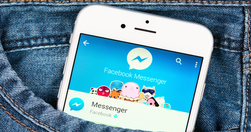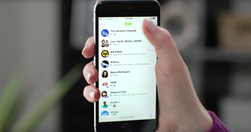Filter 876 resources:
- facebook (337)
- media (127)
- social media (121)
- news (117)
- comments (94)
- disinformation (87)
- community (83)
- medium (75)
- bot (73)
- participation (58)
- algorithm (54)
- mobile (53)
- filter bubble (51)
- data visualisation (42)
- ai (40)
- content strategy (38)
- design (36)
- tool (31)
- eu (30)
- blogging (30)
- curation (29)
- troll (29)
- instant articles (26)
- twitter (26)
- us2020 (26)
- privacy (25)
- platform (25)
- psychology (25)
- politics (23)
- interactive (23)
- promotion (22)
- google (21)
- journalism (20)
- web (20)
- factchecking (20)
- democracy (20)
- advertising (19)
- covid19 (19)
- video (17)
- storytelling (17)
- transparency (17)
- metrics (17)
- regulation (16)
- audiovisual (16)
- ux (16)
- ocm (16)
- analytics (15)
- cms (15)
- data (15)
- trump (14)
- app (14)
- censorship (14)
- trust (14)
- newsletter (13)
- attentionweb (13)
- open web (13)
- amp (13)
- information architecture (13)
- realtime (12)
- data journalism (12)
- animation (12)
- conspiracy (12)
- us (12)
- engagement (12)
- blog (12)
- gamification (11)
- semantic (11)
- egovernment (11)
- linkedin (11)
- native advertising (11)
- livestream (11)
- nytimes (10)
- strategy (10)
- enewsletter (10)
- deletefacebook (9)
- communications (9)
- innovation (9)
- cofoe (9)
- evidence-based policy (9)
- content marketing (9)
- technology (9)
- cambridge analytica (9)
- polarization (8)
- online architecture (8)
- policy (8)
- bloggingportal (8)
- longform (7)
- open source (7)
- minimalist (7)
- productivity (7)
- html5 (7)
- science (7)
- hate (7)
- content (7)
- machine learning (7)
- k4p (7)
- moderation (7)
- myhub (7)
- tv (7)
- newsroom (6)
- delegitimise (6)
- google analytics (6)
- notification (6)
- interface (6)
- web design (6)
- apple (6)
- ec (5)
- ewrc2017 (5)
- blockchain (5)
- qanon (5)
- addiction (5)
- cognitive (5)
- backfire effect (5)
- nlp (5)
- instagram (5)
- knowledge management (5)
- messaging (5)
- peakbot (5)
- augmented reality (5)
- quartz (5)
- event (5)
- ethics (5)
- ea (5)
- clickbait (5)
- guide (4)
- coral (4)
- snapchat (4)
- chat (4)
- psychometrics (4)
- information (4)
- gender (4)
- free (4)
- ai4communities (4)
- marketing (4)
- identity (4)
- ello (4)
- facebook live (4)
- surveillance (4)
- fbpaper (4)
- cookies (4)
- cards (4)
- mybot (4)
- visualisation (4)
- viral (4)
- fediverse (4)
- multilingualism (4)
- sentiment analysis (4)
- science communication (4)
- social marketing (3)
- humour (3)
- digital transformation (3)
- management (3)
- startup (3)
- propaganda (3)
- ui (3)
- conversational (3)
- business model (3)
- audience research (3)
- agile (3)
- publicsphere (3)
- free speech (3)
- internal communications (3)
- big data (3)
- pay4content (3)
- science journalism (3)
- local (3)
- climate (3)
- stream (3)
- buzzfeed (3)
- live (3)
- visual (3)
- uk (3)
- multimedia (3)
- paywall (3)
- conversation (3)
- slack (3)
- copyright (3)
- gdpr (3)
- authenticity (3)
- future (3)
- europcom (3)
- publication (3)
- b2b4me (3)
- election (3)
- ep (3)
- amazon (3)
- responsive (3)
- fblabrats (3)
- paper (3)
- publicsector (3)
- letters2eu (3)
- vandenbrande (3)
- brussels bubble (3)
- collective intelligence (3)
- antitrust (3)
- 2ndbrain (3)
- roamresearch (3)
- echo chamber (3)
- domestic (3)
- listicle (2)
- gawker (2)
- narratives (2)
- twitterenvy (2)
- rss (2)
- nsa (2)
- youth (2)
- ft (2)
- bias (2)
- machine text (2)
- lobby (2)
- youtube (2)
- deep fake (2)
- campaign (2)
- brand (2)
- society (2)
- trending (2)
- zettelkasten (2)
- reddit (2)
- project management (2)
- infographic (2)
- text (2)
- government (2)
- blm (2)
- persuasion (2)
- leadership (2)
- livefyre (2)
- network effect (2)
- bestof2015 (2)
- suppress (2)
- media literacy (2)
- publishing (2)
- canonical debate lab (2)
- credibility (2)
- filter (2)
- groupthink (2)
- brexit (2)
- pilot (2)
- collaboration (2)
- headline (2)
- statistics (2)
- adblock (2)
- mvp (2)
- partisan (2)
- seo (2)
- buzzbot (2)
- faq (2)
- eci (2)
- 3d (2)
- andy matuschak (2)
- jeff jarvis (2)
- hoax (2)
- team (2)
- influence (2)
- tumblr (2)
- gif (2)
- vote (2)
- happiness (2)
- fascism (2)
- cory doctorow (2)
- monopoly (2)
- wearable (2)
- interoperability (2)
- training (2)
- software (2)
- narcissism (2)
- populism (2)
- tribe (2)
- cor (2)
- crowdsourcing (2)
- scrollytelling (2)
- data4policy (2)
- mastodon (2)
- moments (2)
- feed (1)
- mixed reality (1)
- data enrichment (1)
- stack overflow (1)
- seamful (1)
- micro-moment (1)
- d2d (1)
- counter speech (1)
- willpower (1)
- intranet (1)
- datamining (1)
- apple news (1)
- upday (1)
- samsung (1)
- signaltonoise (1)
- webgl (1)
- syndication (1)
- mooc (1)
- membership (1)
- diig (1)
- dao (1)
- smartcities (1)
- epsc (1)
- autonomous (1)
- referendum (1)
- knowledge visualisation (1)
- homepage (1)
- cx (1)
- assist (1)
- europe (1)
- fiction (1)
- tag (1)
- usa (1)
- elon musk (1)
- editorial (1)
- keyword (1)
- buffer (1)
- hype (1)
- ixd (1)
- crisis (1)
- reinventing (1)
- image (1)
- egov (1)
- digg (1)
- self-management (1)
- economics (1)
- open science (1)
- knowledge graph (1)
- d3 (1)
- explainer (1)
- context (1)
- fotl (1)
- millennials (1)
- car (1)
- traffic (1)
- iot (1)
- europa (1)
- ma parent (1)
- roi (1)
- hyperknowledge (1)
- eparltv (1)
- i-book (1)
- photography (1)
- eptv (1)
- trends (1)
- social login (1)
- consultation (1)
- lgbt (1)
- shortform (1)
- icebucketchallenge (1)
- confirmation bias (1)
- google+ (1)
- paid (1)
- chatgpt (1)
- theme (1)
- kpi (1)
- portal (1)
- timeline (1)
- paradigm (1)
- anonymity (1)
- archive (1)
- wayback (1)
- ipad (1)
- taxonomy (1)
- linked data (1)
- ecas (1)
- register (1)
- screencast (1)
- adaptive (1)
- liquid (1)
- chinese (1)
- upworthy (1)
- cmv (1)
- llm (1)
- civil rights (1)
- right (1)
- expiration (1)
- governance (1)
- bloom (1)
- faceted search (1)
- snowden (1)
- internet of things (1)
- convert (1)
- cro (1)
- game (1)
- basic (1)
- customers (1)
- votewatch (1)
- mep (1)
- top3pods (1)
- web2.0 (1)
- podcast (1)
- agent (1)
- mojo (1)
- supergirl (1)
- grassroots (1)
- experiment (1)
- cultural exchange (1)
- humility (1)
- curatorbot (1)
- messenger (1)
- osmo (1)
- language technology (1)
- learn (1)
- debatehub (1)
- ep2014 (1)
- sensecraft (1)
- roaming (1)
- ip (1)
- eesc (1)
- nhscitizen (1)
- visualization (1)
- colfdusion (1)
- (1)
- eu09vs19 (1)
- migration (1)
- sortition (1)
- popvox (1)
- decentralised (1)
- report (1)
- bookmarklet (1)
- post-alpha (1)
- hosted (1)
- geofence (1)
- blackpr (1)
- joan westenberg (1)
- cohesion (1)
- eu2024 (1)
- threadapalooza (1)
- gatsby (1)
- substack (1)
- creativity (1)
- virtual reality (1)
- nz (1)
- sage (1)
- antivaxxer (1)
- rail (1)
- intuition (1)
- model collapse (1)
- circuit-breaker (1)
- at4democracy (1)
- pink slime (1)
- usability (1)
- flicc (1)
- ginsburg (1)
- participatory culture (1)
- ghost (1)
- myanmar (1)
- arg (1)
- floc (1)
- standards (1)
- w3c (1)
- crowdtangle (1)
- github (1)
- opengov (1)
- web development (1)
- motivated (1)
- mobocracy (1)
- demographics (1)
- airbnb (1)
- perception (1)
- crowdfunding (1)
- writing (1)
- quora (1)
- debunk (1)
- inoculation (1)
- comics (1)
- optimisation (1)
- 360video (1)
- metaverse (1)
- spambot (1)
- label (1)
- region (1)
- ipr (1)
- sceptic (1)
- stacked note (1)
- ibm (1)
- intro (1)
- uber (1)
- conference (1)
- design thinking (1)
- jobtodo (1)
- eurosceptics (1)
- customer support (1)
- machine translation (1)
- complex (1)
- automation (1)
- tutorial (1)
- gds (1)
- learning (1)
- khub (1)
- ideation (1)
- euractiv (1)
- empathy (1)
- opinion (1)
- russia (1)
- microsoft (1)
- physics (1)
- holacracy (1)
- reflect (1)
- quiz (1)
- transmedia (1)
- snowfall (1)
- coda (1)
- bbc (1)
- blogpocalypse (1)
- disruption (1)
- hoaxy (1)
- share (1)
- notion (1)
- scandinavia (1)
- competition (1)
- facial blindness (1)
- capgras (1)
- health (1)
- emotion (1)
- how to (1)
- logo (1)
- periscope (1)
- deadbot (1)
- craft (1)
- loyalty (1)
- impact (1)
- vox (1)
- prototype (1)
- knowledge panel (1)
- telegram (1)
- fomo (1)
- education (1)
- city (1)
- wechat (1)
- rantic (1)
- cooperatives (1)
- snapshot (1)
- inscrutable (1)
- transport (1)
- taxibot (1)
- atomisation (1)
- multisig (1)
- dni (1)
- guardian (1)
- ambassador (1)
- newsfeed (1)
- china (1)
- parse.ly (1)
- wapo (1)
- experience (1)
- ethereum (1)
- pwa (1)
Relevant Overviews
- Communication Strategy
- Content Strategy
- Online Strategy
- Online Community Management
- Social Media Strategy
- Content Creation & Marketing
- Online Architecture
- Digital Transformation
- Change & Project Management
- Innovation Strategy
- Communications Tactics
- Social Web
- Media
- Politics
- Communications Strategy
- Science&Technology
- Business
Overview: Online Strategy
How should your online presence be shaped?
Is your website working? Do first-time visitors understand what you do, and find the content they need, before clicking away? If not, should you tweak your site or build a new one?
Perhaps you should spend more resources on social, but to do what: engage your audience, convene a community, or simply broadcast your website content?
How can you do both so that your social media presence and your website work together? And what are you measuring, so that you continuously improve?
Need help? Get in touch.
More services: start with Communication strategy.
Relevant resources

all the pros and cons had to be considered. Here are some of the reasons and learnings behind this decision.

“a monopoly of content distribution that will be mainly driven by user-generated content, and by professional content by commercially interested players.... pretty traumatic scenario of information or propaganda. It will be very painful for democracies.”

“the news on Facebook is what Facebook says it is.”... before the arrival of the internet news in newspapers was what newspapers said it was... the controllers of news outlets - newspapers, TV and radio, online - make choices about what to publish and, more significantly, what not to publish. Facebook’s increasing dominance over advertising is c…

This idea is counterintuitive for us bot-developers because it seems to go against the whole idea of natural language processing.But I quickly realized that suggesting questions was really important... who wants to physically type out an entire question?.. SelenaBot ... also does a quiz ... shows you tour dates, social media updates, lets you lis…

at The Information, the subscription-based tech news publisher, comments and community aren’t just intact — they’re a selling point... The Information puts its members front and center. Subscribers get their own bio pages... its subscription call to action entreats visitors not to get access to great information or level up their tech and media k…
‘Ask’ enables editors to create embeddable forms to invite contributions from readers. These could come in several formats, including text, photo, video, audio. The contributions can be (optionally) linked to existing user profiles. Editors can filter, sort, share, and manage the contributions, and then display the best ones in a gallery.
I find value in reader comments that can’t be adequately reproduced elsewhere. The argument that the conversation has migrated to Facebook and Twitter is flawed. ... they are no substitute for having discussion take place where the story itself lives. ... News organizations should fix online comments rather than ditch them... the feedback is... f…

One small tag for Facebook, one giant disaster for your favorite publishers... For publishers sharing native ads ... have to tag the brand in the post... that brand’s marketing team gets access to the post’s insights... allow savvy marketers to calculate just how big a margin publishers are taking on these campaigns — and potentially walk away fe…

Since Facebook made its livestreaming feature widely available earlier this year, publishers have been experimenting with on-the-spot video in a variety of ways... we are starting a series of in-depth articles chronicling their experiments IBTimes UK has been working on three different live video formats: Q&As with columnists and reporters, panel…

“We were keen to test on small niche audience... Bots will work better when they are more targeted.”... On the transfer deadline day ... 43 percent of chatbot subscribers clicked through ... On an average day ... closer to 23 percent. engagement is high because an individual is choosing to engage with it and the experience is ... personal... ca…

Within five years robots and so-called intelligent agents will eliminate many positions in customer service, trucking and taxi services, amounting to 6 percent of jobs... The bots of 2021 will be much better at understanding human language, and they will be better at learning from users and increasingly able to handle more complex scenarios.

Facebook found itself in the middle of another media controversy last week... like watching an old couple fight: they are nominally talking about the same episode, but in reality both are so wrapped up in their own issues and grievances that they are talking past each other... Facebook screwed this up. But that doesn’t change the fact that Facebo…
Quick response to Baekdael’s Are you under estimating prototyping?, over on Medium: "Your excellent post reminds me of a participation project a few years ago for a government organisation. Ostensibly, it was going to ‘open up’ EU decisionmaking to the public ..."

We’re serious journalists who understand audiences and analytics. But we see a plethora of story ideas — and people — in all of that data.

Most bots today are a simple one and done... draw a crowd, people play with them temporarily only to disregard them minutes later... a huge opportunity for those of us who can create a remarkable experience... Here are a couple of insights:

Instead of pushing news, it’s going to gather news. ... It’s not only going to tell you funny, interesting, and insightful stuff. (Although it will.) It’s also going to ask questions... depending on whether you’re a conventiongoer, a protester, or watching along at home. And it will use those reactions and inbound information to inform BuzzFeed Ne…

to connect with protesters and delegates on the ground ... and to experiment with what it looks like to deploy a bot as a reporting assistant.Now we’re delighted to share the code behind it:

One of the most critical elements to creating a great bot is copywriting. The right words can keep your users engaged for hours while the wrong ones will leave them running for the hills... Your chatbot should have a single minded focus and anything that does not adhere to this focus should be stripped away.

so far, there has been no killer bot... we’re only four months into this... I believe we’ll look back on the early emphasis on “conversational commerce” as a mistake... natural language processing and artificial intelligence are not yet accomplished at managing human-like conversations... instant interactions are key.

some examples of a blended interface, bringing the best of the command line and GUI paradigms together... — notifications and quick input from the conversational side, along with a rich and intuitive experience from the GUI side... Each message has the potential to be a ,,, bite size applications like a photo carousel, media players, mini games, i…

This new tool shows users what Facebook determines are their interests... has provided a glance into the deep flaws of Facebook’s interest targeting. Advertisers should be concerned about where their dollars are going... Here are the main flaws I came across:... I would just recommend approaching targeting differently:

The start of every day for me was Medium, I would import a story from the Buffer blog and edit it before publishing and then spending some time updating all of the tracking spreadsheets with the latest numbers, hoping for an indicator of what was working and what content should be posted tomorrow. Our top three Medium strategies were: Repost o…

This is the future of mobile news, as Quartz envisions it. In the app, which launches today and is Quartz’s first, you don’t read the news; you chat with it.

publishers are afraid that while the AMP project is nominally open-source, Google is using it to shape how the mobile web works, and in particular, to ensure a steady stream of advertising revenue

my view of the many different types of visualizations available to us when we encode and present data... We’ve plotted nearly 90 different graphics across five main categories: Distribution, Time, Comparing Categories, Geospatial, Part-to-Whole, and Relationships. The space does not include every type of graphic, nor does it display every link bet…

IT’S been just over four months since The New York Times started producing live video for Facebook... a lot should never have made the team... many that are either plagued by technical malfunctions, feel contrived, drone on too long, ignore audience questions or are simply boring... For The Times the goal is twofold... to develop video that appea…

a lot of media sources you don’t recognize ... a new and distinctive sort of operation ... political news and advocacy pages made specifically for Facebook... engineered to reach audiences exclusively in the news feed... Occupy Democrats; The Angry Patriot; US Chronicle... together make up 2016’s most disruptive, and least understood, force in med…

Deepstream makes it easy to remix one or more livestreams by adding context and background... by introducing a new role into the livestreaming ecosystem: the curator... easily embed live video into a player that includes context cards... set up with just a few clicks to feature news stories, polls, maps, tweets, free text and more to help you expl…
In response to "The Tyranny of Agile"... Don’t get me wrong — in theory it sounds great to release half-checked, bug-ridden websites for your users to check in the name of agile... But websites delivering actual governmental services really badly IRL can ruin people’s lives...
No matter what the original post was about, a handful of the loudest — or most committed — voices in the room hijacked the comments thread to push their own agendas. Anyone trying to urge the conversation back to the topic at hand ...was shouted down and shamed... comments sections aren't fostering conversation, they are killing it. A very small…
Loading more...
Relevant Overviews
- Communication Strategy
- Content Strategy
- Online Strategy
- Online Community Management
- Social Media Strategy
- Content Creation & Marketing
- Online Architecture
- Digital Transformation
- Change & Project Management
- Innovation Strategy
- Communications Tactics
- Social Web
- Media
- Politics
- Communications Strategy
- Science&Technology
- Business